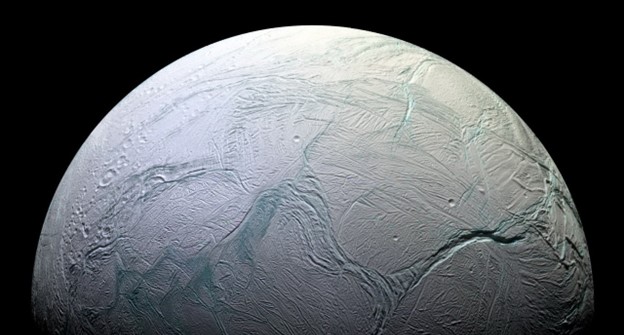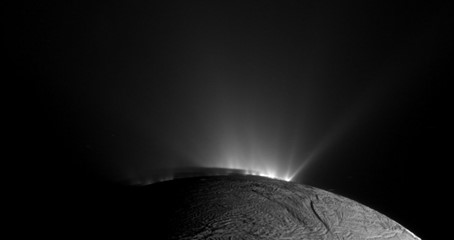by Rida Fatima

(Fig 1: This chain of craters on Enceladus looks like a Saturnian snowman, but it’s actually made from snow draining into fissures underneath. Picture Credits: JPL-Caltech/NASA, Space Science Institute)
Enceladus, the moon of Saturn, is completely covered in snow. According to recent studies, the downy substance can reach depths of 700 metres in some locations. Few planets in our solar system are more captivating than Saturn’s icy ocean moon Enceladus. Only a few worlds are known to have liquid water seas beneath their icy shells, however Enceladus discharges its ocean into space, where a spacecraft like Cassini can sample it.
According to planetary scientist Emily Martin, who is referencing to the infamously snowy city in New York, “it’s like Buffalo, but worse.” According to a research by Martin and colleagues in the Icarus on March 1, the snow depth raises the possibility that Enceladus’ dramatic plume was more active in the past.
Since the Cassini probe discovered Enceladus’ water- and other-vapor-fueled geysers in 2005, planetary scientists have been fascinated by these discoveries. The salty ocean beneath the frozen shell is most likely where the spray comes from (Grossman, 2023). One of Saturn’s rings is formed by some of that water. The majority of it, according to Martin, returns to the lunar surface as snow. Understanding the features of that snow, such as its thickness and density and compactness, may serve to enlighten Enceladus’ past and pave the path for future missions to this moon.
“If you’re going to drop a robot there,” says Martin of the National Air and Space Museum in Washington, D.C., “you need to realize what it’s going to crash into.” Martin and colleagues compared Earth’s snow cover to that of Iceland to establish the thickness of Enceladus’ snow. Furthermore, pit chains, which are lines of pockmarks in the earth caused by loose debris such as rocks, ice, or snow flowing into a crack beneath, are a geological phenomenon visible throughout the island nation (Grossman, 2023).
Measuring The Depth Of The Snow
All around the solar system, including Enceladus, similar features can be observed. Previous research provided a method for measuring the depth of the pits using geometry and the angle at which sunlight strikes the surface. The depth of the substance the pits are buried in can then be determined by that measurement. Martin and her coworkers were sure that the same method would be effective on Enceladus after a few weeks of fieldwork in Iceland in 2017 and 2018. Martin and other researchers discovered that the snow’s thickness varies across Enceladus’ surface using pictures from Cassini. Most of the time, it is hundreds of meters deep, and at its thickest, it is 700 meters deep (Grossman, 2023).
Enceladus Sprays Dramatic Plumes Of Water Vapor

(Fig 2: Rows of plumes rise from ice fractures on the surface of Enceladus. Picture Credit: NASA/JPL-Caltech, via Space Science Institute)
Martin, on the other hand, says it’s impossible to understand how all that snow got there. If the plume’s spray was constant, it would take 4.5 billion years, or the entire history of the solar system, to collect that much snow on the surface. Even so, the snow would have to be extraordinarily fluffy. Martin believes it is unlikely that the plume triggered and remained consistent at the same time as the moon developed. Even if it did, further snowfall would have compressed the previous layers, resulting in a much thinner stratum than it is now. (Chang, 2017).
Martin stated in a research discussion, “It makes me think we don’t have 4.5 billion years to do this.” The plume may have been considerably more active in the past. “We must do it in a lot less time. The plume has to be turned up loud and clear. Shannon MacKenzie is a planetary scientist at the Johns Hopkins University Applied Physics Laboratory in Laurel in Maryland, according to Shannon, the idea is amazing. Without rovers or astronauts on the ground, it is difficult to sweep away snow and measure its depth. Instead, the writers are expertly leveraging geology as their rovers and shovels.
MacKenzie oversaw a mission concept study for an orbiter and lander that might someday travel to Enceladus, but she was not involved in the new work (Grossman, 2023). The study’s main concern was where a lander could land without risk. What do we anticipate the surface to be, she says, was crucial to those conversations? “Identify the places that are too fluffy to land in,” according to the new paper.
References
- Grossman, Lisa. “Enceladus Is Blanketed in a Thick Layer of Snow.” Science News, 13 Jan. 2023, www.sciencenews.org/article/enceladus-snow-saturn-cassini.
- Chang, Kenneth. “Plumes From Saturn’s Moon Enceladus Hint That It Could Support Life.” The New York Times, Apr. 2017, www.nytimes.com/2017/04/13/science/saturn-cassini-moon-enceladus.html.
- Enceladus. (2019 , December 19). Retrieved from Solar system Exploration NASA: https://solarsystem.nasa.gov/moons/saturn-moons/enceladus/in-depth/.
